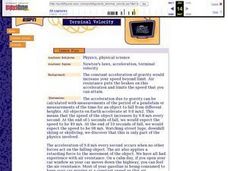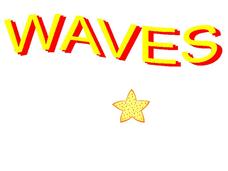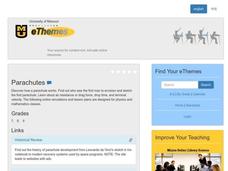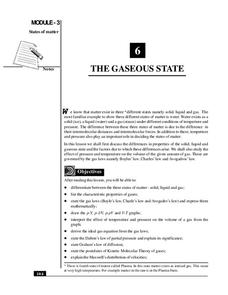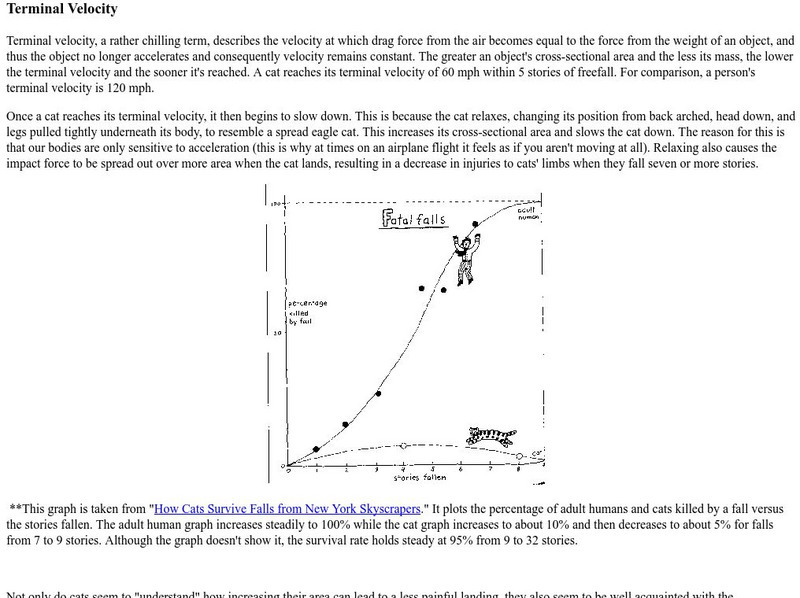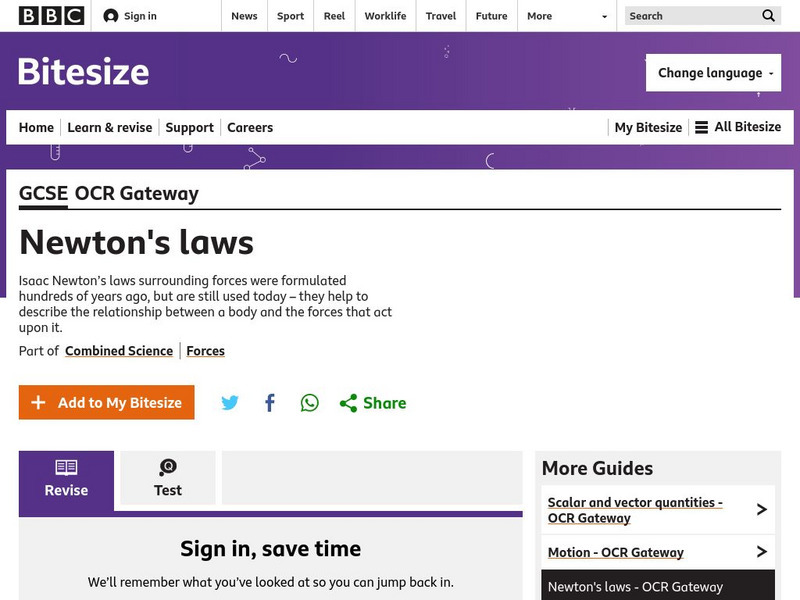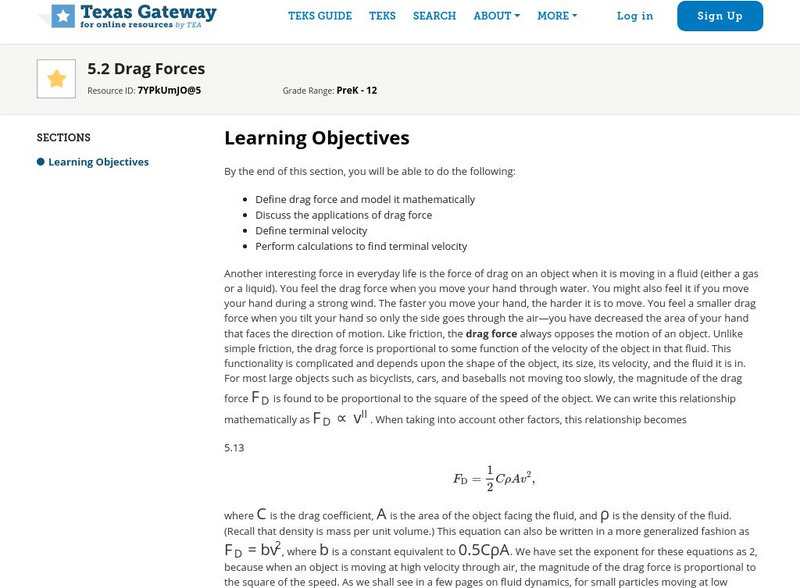Curated OER
Terminal Velocity
Students calculate acceleration due to gravity with the measurements of the period of a pendulum or measurements of the time for an object to fall from different heights. They observe and measure the effect of air resistance on the...
Teach Engineering
Egg-cellent Landing
The classic egg-drop experiment gets a new bounce with an activity that asks pairs to design a lander similar to one used to land a rover on Mars within a fixed budget. The activity provides a great introduction to the idea of terminal...
Urbana School District
Forces
Is your class struggling with Newton's Second Law? Then show them a presentation that covers everything physics scholars need to know about forces. Starting with gravity, the slides focus on Newton's Laws of Motion, and end with an...
CK-12 Foundation
Cliff Diver
Cliff diving is more than an adrenaline rush ... it's a lesson in physics! Scholars adjust the height of a cliff and plot the resulting velocity and position over time on graphs. They also can incorporate air resistance to monitor the...
Curated OER
Gravity Study Guide
In this gravity worksheet, learners define terms such as free fall, terminal velocity, and inertia. Then students compare the different types of forces that act upon objects. This worksheet has 9 short answer and 4 fill in the blank...
Curated OER
Newton's Second Law
In this Newton's law of motion worksheet, students review the concepts and equation associated with Newton's second law of motion. Students complete 7 matching and 5 true or false questions.
Curated OER
Motion Near Earth
In this motion worksheet, students will match 5 physics vocabulary words relating to motion with their definitions. Then, they will review 9 statements of different motion scenarios to determine is the statement is true or false....
Curated OER
Waves
An incredibly colorful PowerPoint presents all the facts and definitions about waves that you could need for beginning physical scientists. There are several useful links to online animations of wave action. This may have been produced...
Teach Engineering
Measuring Viscosity
Groups use a marble to determine the viscosity of household fluids. The procedure calls for pupils to measure the amount of time it takes a marble to fall a specified distance in the fluids. Using unit conversions and algebra, the teams...
Curated OER
Parachutes
Pupils examine how parachutes work, and research and discuss the first man to envision and sketch the first parachute. They analyze air resistance, drag force, drop time, and terminal velocity.
Curated OER
The Drag of Drag
Students are told that any object moving through a fluid (air, water, molasses, etc) experience a drag force which oppose the motion. They are given the summarized version of drag which is proportional to the square of the velocity....
National Institute of Open Schooling
The Gaseous State
Sixth in a series of 36, this lesson focuses on gases and their behavior in given situations. Learners review the states of matter and then focus on gases, specifically learning Boyle's, Charles's, Avogadro's Laws, Dalton's, and Graham's...
Curated OER
Design a Bobsled
Students apply their knowledge of friction, drag, mass and gravity as they design, build, and test mini-bobsleds.
Curated OER
Free Fall
Students investigate the law of gravity and how an object can accelerate while going through a free fall. They examine the influence of air resistance and how it can influence the momentum of an object. The lesson contains background...
Curated OER
Does Weight Affect Drag?
Learners investigate how weight affects a parachute's rate of fall. In this investigative lesson students test parachutes, average results and conclude what makes a faster descent.
Curated OER
Earthquake on the Playground
Learners investigate earthquakes by examining chart data. In this disasters instructional activity, students identify the waves that are recorded when an earthquake arises by reading sample graphs in class. Learners participate in an...
Curated OER
Earthquakes
Eighth graders demonstrate the mathematical components of a scientific problem as well as illustrate how real world problems can be solved using math. They demonstrate math skills such as rate calculation, graphing, and linear equations.
Curated OER
Nervous Tissue
In this nervous tissue worksheet, students list and describe the functions of the nervous system and its two principle parts. Then they list and give the function and location of the six types of glial cells. Students also describe two...
National Geographic
National Geographic: Terminal Velocity
Researchers compare the terminal velocity of humans to peregrine falcons in hopes to increase top speeds in human extreme skydiving.
Other
University of Alaska: Terminal Velocity
University of Alaska physics professor site explaining the concept of terminal velocity. Uses the terminal velocities of humans and cats for comparison. Site contains an interesting graph of the percent fatalities versus stories fallen.
University of Colorado
University of Colorado: Ph Et Interactive Simulations: The Moving Man, Motion, Velocity, Acceleration, Position
Enhance study of motion, velocity, acceleration, position and graphing with this interactive simulation.
Khan Academy
Khan Academy: Velocity and Acceleration Vectors
This 11-problem quiz/practice helps students to understand how velocity and acceleration can be represented using vectors.
BBC
Bbc: Gcse Bitesize: Newton's Laws
This lesson focuses on Newton's Law for falling objects including terminal velocity, the three stages of falling, a diagram showing what happens to the speed of a skydiver from airplane to ground, velocity-time graphs for falling...
Texas Education Agency
Texas Gateway: 5.2 Further Applications of Newton's Laws: Drag Forces
By the end of this section, you will be able to define drag force and model it mathematically, discuss the applications of drag force, define terminal velocity, and perform calculations to find terminal velocity.


